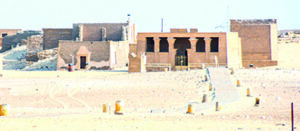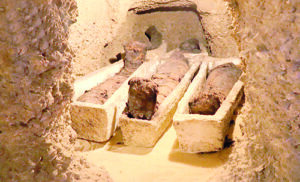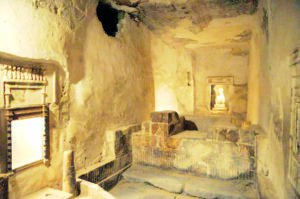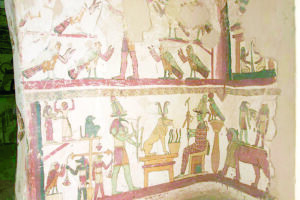The tomb of Petosiris, a main feature of Tunah al-Jabal, the necropolis of Khmun in the central city of Minya, is a must visit.
Petosiris, a high priest of Thoth, the god of the moon, reckoning and writing in the ancient Egyptian religion, built the tomb for himself, his father Shesu, his brother Djed-thoth-iw-f-ankh, and his son Zeho.

Three generations were buried in this tomb which is the only free-standing tomb that takes the shape of the façade of an Egyptian temple dating back to the early Greco-Roman Period, especially the reign of Ptolemy I.
The tomb of Petosiris is built from both limestone and sandstone. It takes a rectangular shape, measuring 6 metres in width and 7 metres in length.
It is famous for its mixed iconography that features daily life scenes. These scenes appear in blue colours, demonstrating Greek influences that appeared for the first time in this tomb.
Petosiris and his workers all appear in the frontal view. The male and female figures appearing in this view are all dressed in Greek tunics. They have curly hair.
The tomb’s high stone altar is one of its most important attractions. The façade of the tomb consists of four columns attached to one another by means of screen walls.
The two columns on the sides have palm leave capitals on them, while the two in the middle have composite floral ones.

On either side of the entrance, there is the speech of Petosiris addressed to the visitors of the tomb.
In this speech, he asks them to make offerings to him in the form of 1,000 bears, 1,000 wine bottles, 1,000 oxen and 1,000 fowls.
As for the screen walls of tomb, they are also decorated with various scenes and inscriptions.
The first two screen walls on both sides of the entrance doorway are decorated by the autobiography of Petosiris and his family members.

The two screen walls in the middle are decorated with a scene of Petosiris in front of god Thoth in his Ibis form.
The two outer screen walls are decorated with a similar scene of Petosiris, but in front of Thoth in the form of a baboon.
As for the pilaster on the extreme outer sides, it is divided into three registers, depicting Petosiris in front of different deities.
The bottom register, in the right side, shows him standing before Nephthys, the middle one in front of Osiris, and the uppermost one in front of Sokar.
As for the left side, the lower register represents Petosiris before Isis, the middle one before Osiris, and the uppermost one in front of an unidentified deity whose head is damaged.

The entrance of the Tomb of Petosiris leads to a rectangular hall with walls vividly decorated with scenes of daily life, ones that show a mix iconography.
One of the scenes depicted on the walls features two men seated on either side of a heap of berries from which they are removing the bad ones. A third man is shown empting a sack of berries into the heap.
Lower down, the scene shows two methods of crushing the berries to extract oil. Carpenters making funerary furniture and goldsmiths are also featured melting the gold to make jewellery.
There are also some depictions of agricultural scenes where the lower register shows workers ploughing the land, and throwing the seeds.
The middle register shows farmers harvesting flax and collecting it in bundles. The top scene shows farmers harvesting and threshing wheat.
Petosiris, his wife and members of their family are depicted on the sides of the entrance to the tomb.
On the top and middle registers, there are scenes of cattle breeding. In one of the scenes, an ox is mating with a cow, which gives birth to a calf. Another scene shows a man sitting underneath a cow and milking it.
Tunah al-Jabal can be reached from the centre of Minya via multiple transport options, including buses operated by the tourist companies of the city.
Minya can also be reached easily from Cairo’s Ramses Square where trains departing to the central city work round the clock.







Discussion about this post